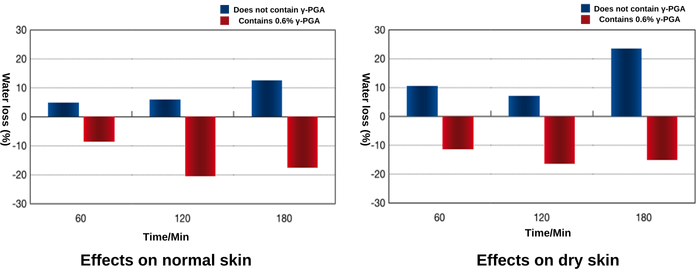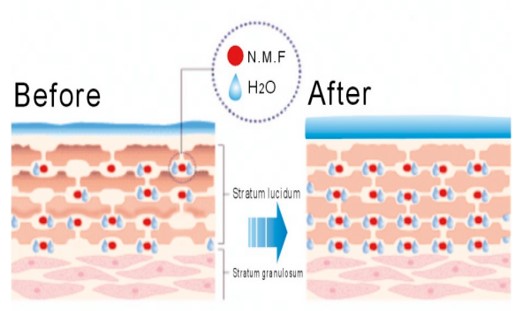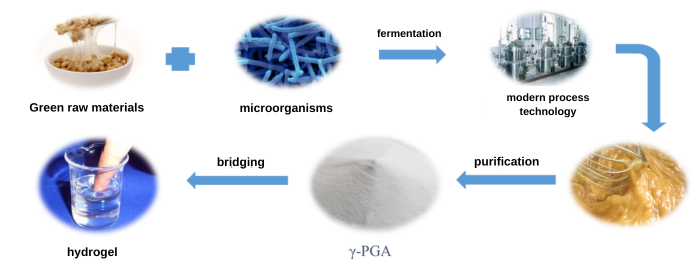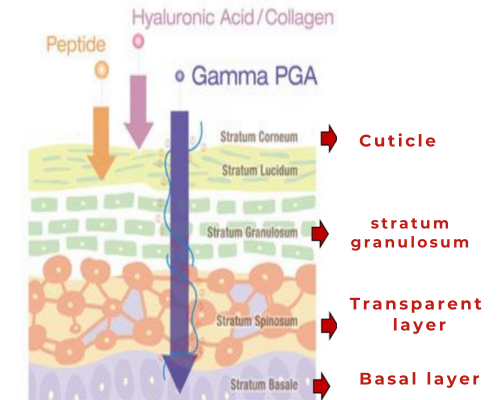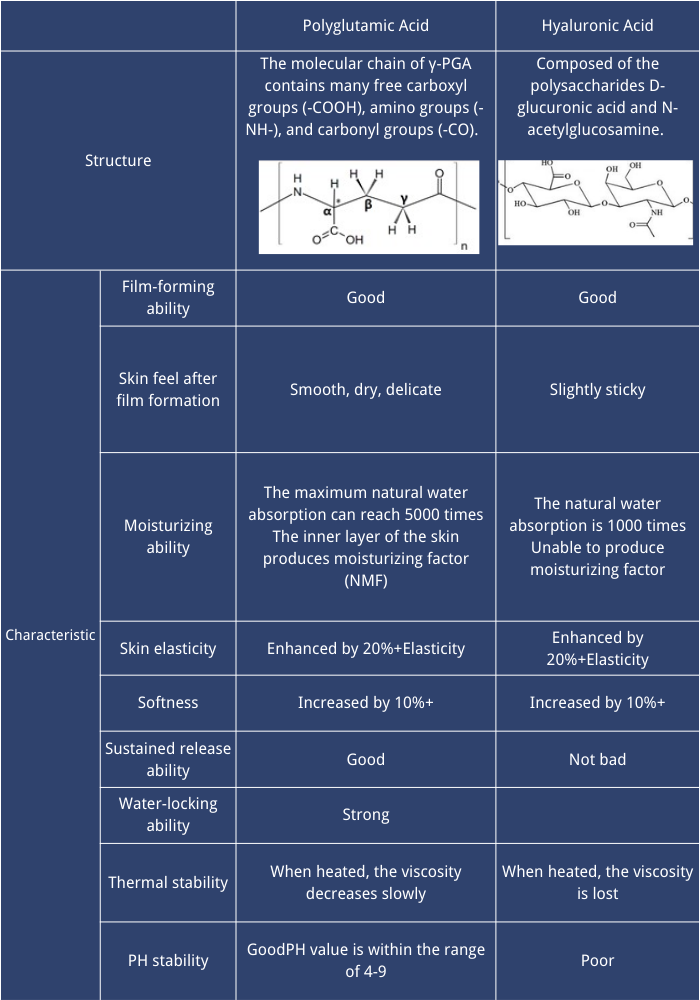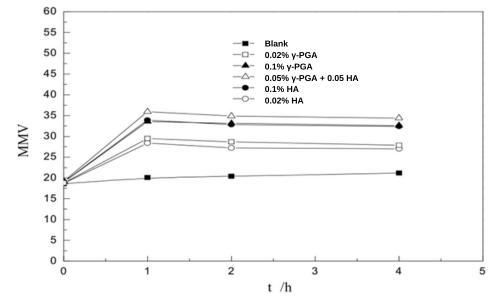Polyglutamic Acid: A “Better Alternative” to Hyaluronic Acid for Moisturizing Power
In recent years, it has become quite popular to consume natto to improve the health of the body. Natto contains a variety of beneficial ingredients, among which, γ-polyglutamic acid (γ-PGA) is the main component that makes up the viscous colloid of natto. It not only promotes mineral absorption, but also has superb moisturizing ability. Compared with Hyaluronic acid (HA), which is recognized as the most moisturizing ability, the moisturizing effect of γ-PGA surprisingly exceeds its effect by 2-3 times, making it a new generation of biotechnology moisturizing ingredient.
Polyglutamic Acid: The Most Effective Moisturizer
γ-Polyglutamic Acid (γ-PGA) is one of the few water-soluble polyamino acids that can be naturally produced by microbial fermentation. It is composed of D-glutamic acid and L-glutamic acid, linked together by γ-glutamyl bonds, forming a large polypeptide molecule with a molecular weight ranging from 10 to 2000 kDa.
γ-PGA was first discovered by Ivanovics in 1937. Since Bovarnick found in 1942 that γ-PGA could be freely secreted into the growth medium of Bacillus subtilis as a fermentation product, various bacillus species have been found to produce γ-PGA extracellularly.
The molecular chain of γ-PGA contains many free carboxyl groups (-COOH), amino groups (-NH-), and carbonyl groups (-CO). These structures contribute to its hydration capabilities, with the carboxyl group being particularly effective. Additionally, the presence of numerous hydrogen bonds between γ-PGA chains gives γ-PGA exceptional water retention and locking abilities.
Fig 1. Molecular structure of polyglutamic acid
–The Advantages of Polyglutamic Acid in Skincare
- High-Efficiency Moisturizing
PGA has a natural water absorption capacity of up to 1180.4 times its weight, which is more than twice that of the widely recognized best moisturizer, hyaluronic acid (500 times). If PGA is further cross-linked and modified, it can form a hydrogel with a network molecular structure, reaching an astounding water absorption rate of 5000 times.
Fig 2. γ-PGA can effectively reduce epidermal water loss
- Endogenous Enhancement of NMF Production in Skin
After PGA on the skin surface degrades into small molecular polymers, it can penetrate deep into the skin, inducing the synthesis of the natural moisturizing factor (NMF). By regulating and storing water, it helps maintain the moisture content between keratinocytes, naturally giving the skin a hydrated appearance.
Fig 3. Effect of γ-PGA on the proliferation of skin NMF
- Inhibition of Tyrosinase Activity with Whitening Effects
Research shows that PGA of different molecular weights can inhibit tyrosinase activity in vitro. Higher molecular weight PGA has a better inhibitory effect on tyrosinase than lower molecular weight PGA. While its effect is not as pronounced as common whitening ingredients like kojic acid or vitamin C, PGA is non-irritating to the skin, making it suitable for long-term use. In addition to its powerful moisturizing properties, it can plump the skin and brighten the complexion, resulting in a comprehensive, healthy whitening effect.
- Smooth and Refreshing Sensation
The amino acid units in PGA have a smaller molecular weight and are more skin-friendly. At the same solution concentration, the viscosity of polyglutamic acid is significantly lower than that of hyaluronic acid and collagen, reducing the sticky sensation and providing a clearer, more refreshing feel on the skin.
Additionally, PGA can chelate with metal ions, has good antibacterial properties, film-forming capabilities, strong smoothness, and slow-release abilities, making it an excellent ingredient in cosmetics to enhance and prolong moisturizing effects.
–Production Process of Polyglutamic Acid
There are three main production processes for polyglutamic acid:
- chemical synthesis (traditional peptide synthesis and dimer condensation)
- enzymatic conversion
- microbial fermentation
Due to the limitations of the first two methods, such as low yield, impure quality, operational difficulties, and high losses, the current mainstream method for synthesizing and producing γ-PGA is microbial fermentation, including both liquid and solid fermentation. Among these, liquid fermentation is the most widely used.
Fig 4. Production Process of Polyglutamic Acid
Polyglutamic Acid vs. Hyaluronic Acid
Polyglutamic acid has strong water retention and locking abilities, whereas hyaluronic acid, while also effective at hydrating, has relatively weaker water retention capabilities.
1. Better water absorption
Studies have shown that compared to hyaluronic acid and collagen, PGA can better prevent moisture loss from the skin over a longer period, improve skin elasticity, and provide long-lasting moisturizing effects superior to hyaluronic acid and collagen.
2. Better absorption and penetration
The amino acid structure of γ-PGA is very easily absorbed by the skin up to the basal layer of the skin. In terms of transdermal absorption, it is significantly better than molecules with a polysaccharide structure. Therefore, compared to Hyaluronic Acid, γ-PGA is significantly better in terms of moisturization after a few hours of use, and its long-lasting use can greatly improve the dryness of the skin.
Fig 5. Comparison of the penetration ability of polyglutamic acid and hyaluronic acid
3. Less sticky feeling
At the same solution concentration, the viscosity of polyglutamic acid is significantly lower than that of hyaluronic acid and collagen, reducing the sticky sensation and providing a clearer, more refreshing feel on the skin.
Table 1. Comparison of polyglutamic acid and hyaluronic acid
Case Study: Synergy of Polyglutamic Acid and Hyaluronic Acid
–The Challenge
Hyaluronic acid is a component of the skin’s structure that helps maintain hydration and elasticity. It is also a commonly used, highly effective moisturizing ingredient in skincare products. However, due to the presence of hyaluronidase in the skin, hyaluronic acid degrades quickly.
–The Solution
Polyglutamic acid (PGA) can effectively inhibit the activity of hyaluronidase. Research shows that different molecular weights of PGA exhibit inhibitory effects on hyaluronidase in vitro, with lower molecular weight PGA (100 kDa) demonstrating better inhibition.
Fig 6. Comparison of Polyglutamic Acid and Hyaluronic Acid Complex Effects
When polyglutamic acid and hyaluronic acid are used together, they can slow down the degradation of hyaluronic acid, synergistically enhancing long-lasting moisturizing effects, and effectively reducing the sticky sensation of hyaluronic acid, especially in facial mask products.
Conclusion
Polyglutamic acid has stronger water-absorbing, penetrating and moisturizing properties. It has a non-sticky texture, and when compounded with hyaluronic acid it also adds moisturization after the slippery feeling of HA is gone.
Stanford Chemical Company (SCC) has over 16 years of experience in the manufacture and sale of phytochemicals, pharmaceutical intermediates, catalysts, laboratory equipment and a variety of specialty fine chemicals. The company offers a variety of skin care ingredients such as polyglutamic acid, hyaluronic acid, collagen, salicylic acid, etc. If you need, you can visit our homepage or use the search box to find the product you need.


